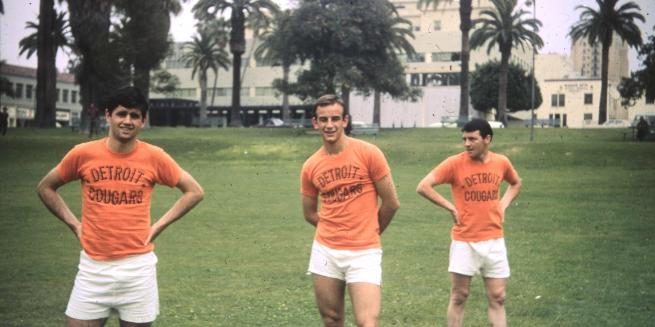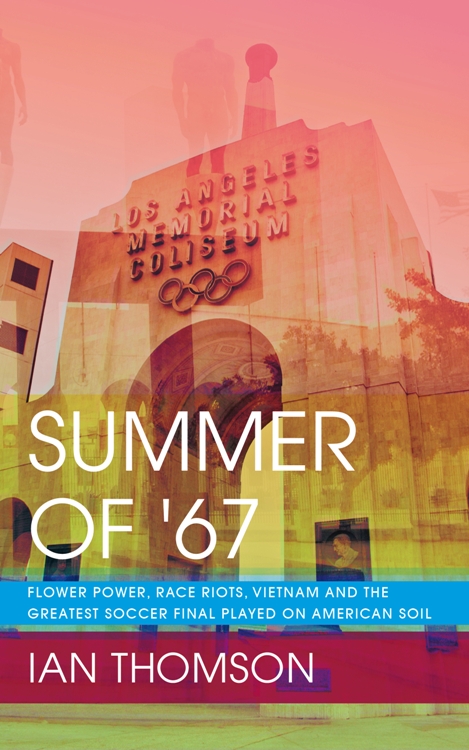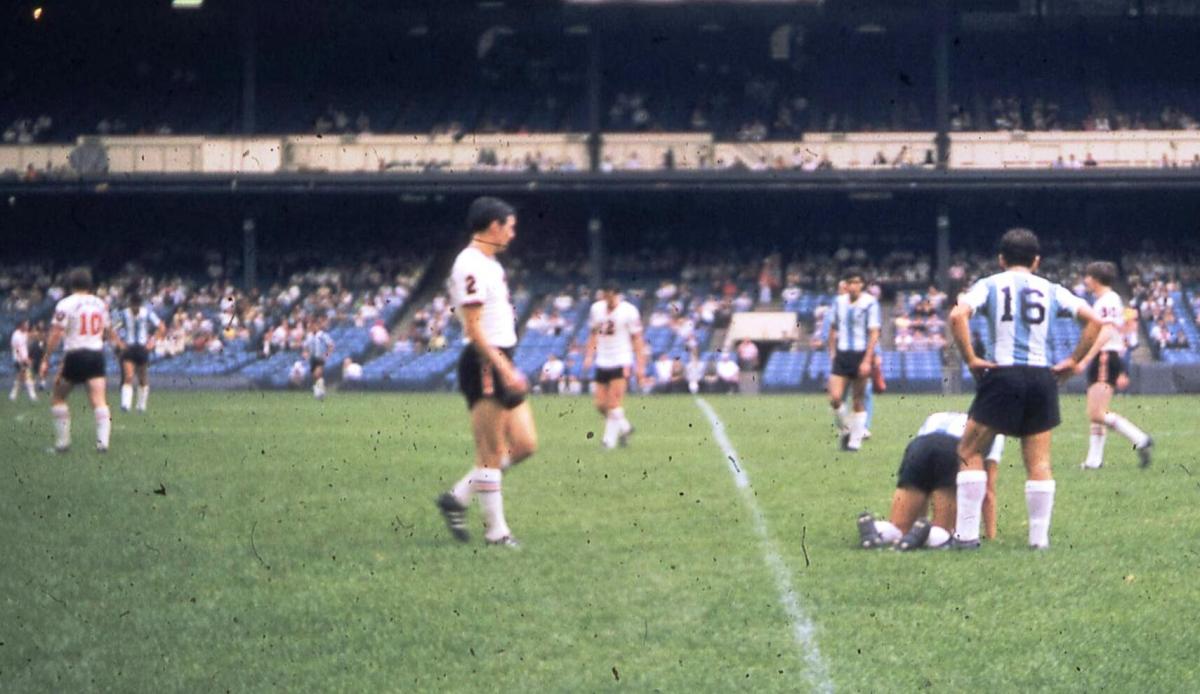
Summer Of ’67 – Glentoran Take on Some of the World’s Best in North America
On July 30, 1966, nine million Americans received their first taste of soccer as a stand-alone broadcast when the NBC channel screened a tape delay of the FIFA World Cup Final between England and West Germany.
Soccer was not new to the United States. Baseball team owners had first tried to create a professional league in 1894 as a way to keep their stadiums in use during the winter. The U.S. finished third in the inaugural World Cup in 1930 and shocked England in Brazil 20 years later, but soccer was still a marginal sport when the 1966 tournament rolled around. Geoff Hurst’s extra-time heroics left viewers captivated and millionaire sports promoters reflecting on soccer’s potential.
“We had the biggest television audience in United States sports history for the Super Bowl game, 65 million viewers,” said Kansas City Chiefs’ owner Lamar Hunt after his side lost the first AFL-NFL championship game in January 1967. “But do you know how many people all over the world watched the World Cup soccer matches? Four hundred million.”
Hunt and his counterparts hastily established the United Soccer Association, a 12-team professional league featuring franchises from as far afield as Boston and Vancouver. If only there were local professional soccer players to fill the squads.
The USA’s solution was to invite foreign clubs to compete in a summer tournament in 1967 to promote the sport before American players could step up the following year. The teams were split into Eastern and Western divisions with each side playing a dozen matches before the respective section winners faced off in the championship decider. Three English teams, three Scottish teams, two from continental Europe and two from South America accepted invitations, while two part-time outfits from Ireland rode the collective fawning of the league’s officials for a British style of play – Shamrock Rovers and Glentoran.
Glentoran were allocated to represent the Detroit Cougars franchise owned by William Clay Ford Sr., a former Ford Motor Company executive and the owner of the Detroit Lions American football team. The Glens traveled to Michigan on the back of winning their 12th Irish Football League championship, the Ulster Cup, the Gold Cup and the City Cup during John Colrain’s first season in charge.
Fans lined the rain-drenched Mersey and Dee streets to wave farewell as the team’s bus left The Oval for the airport on May 23, 1967. A few streets away, construction workers gathered outside the entrance to the Harland and Wolff shipyard to offer their best wishes.

June 14, 1967 – Remarkably, Colrain’s part-timers remained undefeated after four matches as the Houston Stars, represented by Rio de Janeiro state champions Bangu, arrived at the University of Detroit Stadium.
Tensions were rising in Detroit’s African-American neighbourhoods as the summer progressed, but the touring Glentoran players appeared oblivious to the trouble that lay ahead in the city as playing, training and travelling filled the team’s schedule.
Any spare time was mostly spent in downtown sports bars or in the company of hospitable Irish expats who invited the players to social gatherings. A concert by Toronto-based Irish folk group The Irish Rovers afforded them with another team-bonding night out. Emigrant brothers George and Will Millar from Ballymena had formed the band with cousins Ian and Joe. They signed a deal with Decca Records in 1966 and released their debut album, “The First of the Irish Rovers,” later that year. The group, some of whom were Glentoran fans, were on the road promoting their follow-up album called “The Unicorn.”
The only Motor City rioting that the Northern Irishmen were exposed to during their summer tour came during an abridged clash with the Houston Stars watched by 7,196 fans at the University of Detroit Stadium. Fernando Puglia gave Houston the lead after slotting his shot under Detroit goalkeeper John Kennedy, and Aladim Luciano doubled the lead three minutes after the interval with a 25-yard free kick.
Mutual resentment had been brewing as the tough working-class lads from East Belfast took umbrage to the crafty fouls and play-acting of their opponents that went unpunished by the officials.
“Some of their tackles were really bad,” said former Glens winger Eric Ross. “They went over the ball a lot. They went down like a ton of bricks whenever one of our defenders tackled them, and their petulance was incredible.”
The flashpoint arrived on 73 minutes. Danny Trainor vengefully headbutted Houston centre-half Pedrinho in the chest after the Cougars forward had taken a high boot to the head. Tommy Jackson’s attempts to separate the feuding pair were unceremoniously curtailed by a blindsided flying kick from Houston midfielder Jaime that left a studmark wound trailing Jackson’s spine. Roy Borne and Harry Creighton were left nursing scrapes down their sides and back after being hit with similar sneak attacks before their assailants sprinted off, and Trainor also endured a set of studs being raked down his lower back.
Glentoran president Johnston Nelson, a former soldier with the Irish Guards regiment of the British Army, led the charge of staff and substitutes from the sidelines as a mass of bodies joined the ruck from all angles, and Houston’s players uprooted corner flags to use as weapons as they came under attack from furious Detroiters invading the field. Nelson lost his gold watch as he unleashed combinations of lefts and rights at the retreating Brazilians while Glens vice-chairman Jack Dornan indiscriminately swung a large camera bag at anyone within his vicinity.
“I always felt that the South Americans had it in for British teams,” said Ross, citing England’s ill-tempered World Cup quarter-final win over Argentina in 1966 that saw visiting captain Antonio Rattin refuse to leave the field after being sent off 10 minutes before half-time.
Jackson was still receiving treatment around his kidney area as the brawl continued for 10 minutes before the police restored order and referee Eddie Clements formally abandoned the match. League officials confirmed the 2-0 scoreline in Houston’s favor despite Detroit’s protests, and both teams were sternly warned about their future conduct.
“This is a black mark on American soccer,” USA commissioner Dick Walsh said. “We are trying to launch the game here and incidents like those of last night are not doing it any good.”

July 2, 1967 – The Glens travelled to New York to face the Skyliners (Cerro from Uruguay) after a 1-1 draw at the Chicago Mustangs (Cagliari from Italy) in midweek. That impressive result kept them within three points of the Eastern Division leading Cleveland Stokers (Stoke City) with three matches remaining.
John Colrain was a man on a mission when his Detroit Cougars arrived in New York. The booming Glaswegian player-manager had learned that his hero Frank Sinatra regularly frequented a bar called Jilly’s Saloon on Manhattan’s West 52nd Street. Colrain soon befriended the head barman who informed him that Sinatra would be in town that weekend. First though was a Sunday afternoon meeting between the Cougars and the New York Skyliners played amid sweltering heat and high humidity that appeared suited to the professionals from Uruguay rather than the part-timers from Northern Ireland.
Jim Weatherup’s industry was rewarded when he grabbed the only goal for the visitors on 33 minutes. The lively forward beat Uruguayan defender Francisco Camera before firing home from 10 yards despite a valiant attempt by Skyliners goalkeeper Eduardo Garcia. Detroit knuckled down after the interval to protect their lead with a gritty, gutsy display amid 80-degree temperatures, inspired by a sound performance from goalkeeper John Kennedy.
“His legs are as thin as a thoroughbred’s, but his hands are quick and strong and he was the difference in the game,” said New York Times reporter Gerald Eskenazi, describing Kennedy in his match report.
The Skyliners camped around the Cougars’ 18-yard box in the second half, but they were unable to create a clear scoring chance. Referee James Black sparked wild celebrations from the Northern Irish exiles making up the majority of the 3,517 crowd when he blew his whistle for the final time. A hearty rendition of “Here, Here, The Glens Are Here” ringing out from the bleachers carried the Cougars players back to their dressing room.
“It was the piece-de-resistance of five arduous weeks against the toughest of opposition,” wrote the Belfast Telegraph’s Malcolm Brodie in his summary.
Remarkably, Detroit still held an outside chance of advancing to the United Soccer Association championship decider as the Cleveland Stokers traveled to Michigan in midweek.
Colrain resumed the pursuit of his idol shortly afterward by dropping by Jilly’s Saloon on his way back to the team’s hotel. He called Brodie upon his return and asked the reporter to meet him in the lobby.
“We’re going to meet the Chairman of the Board,” Colrain told his good friend.
Sure enough, Sinatra and his entourage arrived at Jilly’s later that night and the two Belfast-based Glaswegians sat drinking into the early hours in the company of Ol’ Blue Eyes.
“Summer Of ’67: Flower Power, Race Riots, Vietnam and the Greatest Soccer Final Played on American Soil” by Ian Thomson charts the story of the United Soccer Association’s creation and demise.
Sixteen players from eight clubs, including former Glentoran winger Eric Ross, share their memories of the capers, the gimmicks, the celebrity brushes and the matches that combined to provide them with the trip of a lifetime.
The book is available now on Amazon.co.uk.........HERE......
Printed version available soon.




